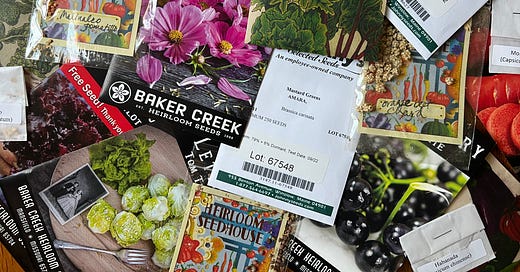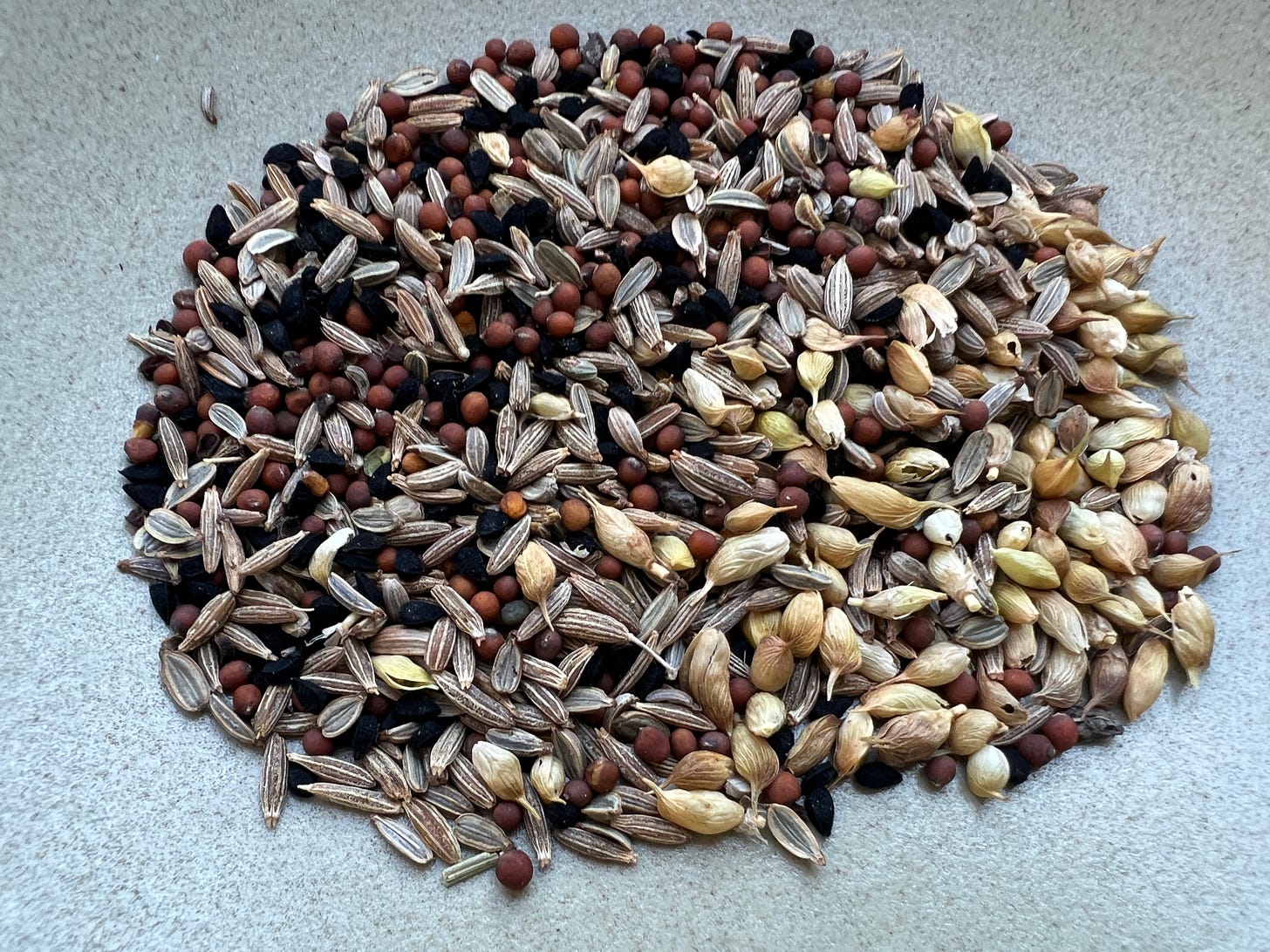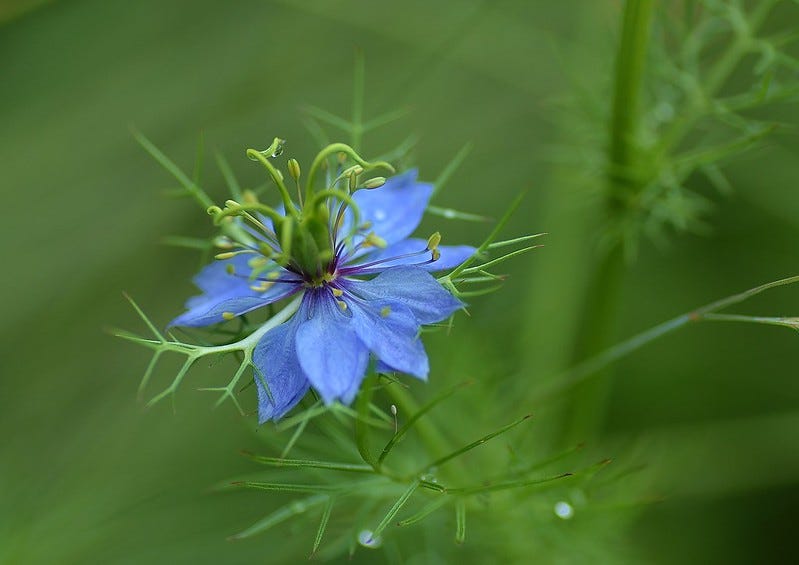Issue 14. Gathering seeds for 2023
Scenes from a year of half-botched foraging and uncontrolled buying
Over the past few months, the seed packets have been amassing on my kitchen counter, a year's worth of promises and future duds.
I've been ordering a few seeds here, a few there, never spending more than $20 at a time. Last weekend, after noticing how swollen the envelope holding the packets has become, I drew up a list of all my purchases. Sure, I’m planning a three-growing-season garden, but I really overshot the mark this time.
With only a few raised beds, I gravitated toward accent crops—vegetables and fruits I can't find at Portland's amazing farmers' markets. Golden orach. Chichiquelite huckleberries. Arroz con pollo peppers. That's in addition to the lettuces, green garlic, and volunteer ground cherries from last year I have already made space for.
Among the crops I'm planning to grow as well: the remnants of last year's thwarted plan to make my own mustard.
Last March, as I was sewing kale and arugula, I realized both seeds looked just like the black mustard seeds in my spice cabinet. (Really, I should have thought about this earlier, since they all belong to the same genus.) I googled "Can you make mustard with brassica seeds?" and discovered a fierce one-upmanship among homesteader creators: Kale seed mustard. Arugula seed mustard. Wild mustard mustard.
I thought of the fields covered in yellow wild-mustard flowers along my favorite bike ride, which traces the shore of the Columbia River. All through the spring, I rode the route with clippers in my backpack to see if the flowers had yet morphed into long, skinny seedpods. The moment happened, though, during my June travels. By the time I returned, the wild mustard was gone.
As summer gave way to fall, I collected other spices where I could. I planted nigella sativa starts from Portland Nursery (tip: always check its herb section), letting the periwinkle flowers wither into tendriled seed pods in order to harvest my own nigella (aka kalonji). Once the starburst blossoms in my neighborhood fennel forest transformed into dark, bobbing sprays of seed, I gathered a bag there, too. Then, one afternoon in August, I told my friend Loree about my mustard misadventures, and she let me clear out the lacinato kale that had gone to seed in her garden. I let the pods dry out in the sun, then spent a few evenings painstakingly splitting them. Tiny brown seeds kept skittering across the dining room, racing toward the nooks and corners.
All in all, it took me a full day's labor to gather a few tablespoons of seeds for my foraged spice cabinet. Each of the jars is still riddled with flecks of chaff that I must pick out.
Sometimes, the ridiculousness of my efforts is hard to ignore.
But I was able to combine all three spices with equal amounts of fenugreek and cumin in order to coat delicata squash in a Portland version of the Bengali spice mix panch phoron. Each time I contemplate making wild fennel biscotti, or sprinkling my own nigella seeds onto seeded breads, I'm reminded why I originally wanted to sketch out a map of my neighborhood in flavors: to recreate the landscape in tiny moments of delight. Delight is always a little ridiculous. Or, perhaps, the ridiculous is what I take the most delight in.
So, this spring, a few lacinato kale and nigella seeds will go into my raised beds. Maybe next to the Ethiopian kale. Or, forgive my hubris, the blue field corn.
I've been accumulating this surplus of uncommon seeds, I think, in search of new flavors. Christian, my husband, has made that my assignment this year: finding more things to look forward to.
Last year was certainly better than 2021, even better than 2020. But after three years of pandemic limbo, I have become so schooled in dutiful resilience that I have lost the ability to think farther ahead. It's a loss that still proves useful: Over the holidays, my parents canceled their trip to the Northwest (blizzard), my sister's family couldn't visit from Seattle (illness), and the basement flooded (long story). It wasn't hard to roll with each of these disappointments—just another set of pandemic shutdowns to absorb.
I thought I had weathered December with equanimity. Then January arrived and I found myself feeling like a can of soda that someone had dropped, all compressed agitation. After Christian issued his assignment, I bought tickets for concerts in May and August. We made plans to travel in the spring, and I gave myself permission to google our destinations, making lists of things I might want to see. In my head, each one of these activities is still smothered in caveats.
So I raised the question with one of the priests at the zendo where I sit every week. When I'm sitting zazen regularly, the grueling exercise of facing a wall, paying attention to my breath, seems to create a cushion of stillness that can catch negative thoughts before they crash into my brain and ignite. But that practice can feel so reactive, I told the priest. How can I look forward to things, especially when the future keeps falling apart?
Maybe, she said after considering the question for a few breaths, you could allow yourself to be open to joy.
I don't yet know what being open to joy feels like. Perhaps it takes the form of a bulging envelope of seeds. I know that some of them will never sprout. Some I'll overwater. Some will be devoured by aphids and rabbits. But some of these seeds may yield a basket of leaves whose like I've never tasted. Others may grow into plants that replenish my spice jars—not a new discovery to look forward to, but welcome all the same.










Hi there! I think opening to joy in the little things in life is what makes it worth living! And I bet you can find joy in the little moments, like gathering seeds. I can say that I planted a few seeds for a relative of marshmallow in "my garden" area downstairs in the building and I am hoping some with come up. I took the originals from a lovely community garden in Jerusalem, that has a much colder and rainy weather, and to my surprise 3 plants came up last year in Eilat, by the dripping irrigation. Eilat is a desert by the sea, so I was surprised that they grew, flowered and died after 2 years. I collected the roots, which are very good in use for the skin and to soothe the digestive system. I have a few other herbs that make it through the year, thanks to drip irrigation, such as salvia, micromeria, a kind of artemisia (very bitter, but I like it in my tea) and since here is very hot, I get eggplants and basil year round. I used to have Nigella in my garden in Santa Rosa, CA, lovely seedpods to decorate your place with and the seeds are yummy in almost anything. And I've got fennel here in the winter, so don't give up and make some seed balls and be ready for a surprise in the spring!
Open to joy! Love that! When you figure out how to do it, please let me know. The drudgery and disappointments of the pandemic have also left me blah; therefore we too are planning vacations...even if they have no dates yet. I guess I'm taking on Christian's assignment, too. For one, I'm looking forward to seeing you next weekend! <3